History
Since the 11th century BC, Fars has been the home of one of the Aryan tribes called “Pars”. The name of this province and the Persian Gulf, which was separated from Fars province in 1973 to became part of Bushehr province, are derived from the name of this tribe.The estimated population of the province is about 5 million.

Geography
Fars province, with Shiraz as its capital, is bordered by Isfahan to the north, Yazd to the east, Hormozgan to the south, Kohgiluyeh and Boyer-Ahmad and Bushehr to the west. This region embraces many plains and deserts, lakes, mountains, valleys and gorges, rivers and springs, while mountainous areas cover 70% of the province’s area.
According to the latest national divisions in 2011, the province includes 29 counties; Shiraz, Marvdasht, Kazerun, Jahrom, Larestan, and Fasa are the most populous cities in Fars province, based on the 2016 census.

Climate
Fars province is divided into three climatic zones: mountainous (with freezing cold winters), central (with relatively mild winters, hot and dry summers), and the third zone with mild winters and scorching hot summers.
The best time to travel to this province is proven to be in May; when the scent of orange blossoms delights people and fascinates tourists with the alleys and gardens of Shiraz.
Cities of Fars Province
Fars province has ancient cities, historical monuments, natural attractions, pilgrimage sites, and beautiful Persian gardens that cater to different tastes.

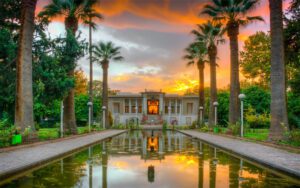
Shiraz
Shiraz is the capital of Fars province; It has been famous for its beautiful gardens since ancient times. Some of its gardens are of historical importance and are considered significant tourist centers. The Eram Garden, Afif Abad Garden, Delgosha Garden, and Jahan Nama Garden are spectacular among them.
The presence of two great Persian poets, Hafez and Saadi, in Shiraz has influenced various cultural and linguistic aspects of the people of this city. Today, the mausoleums of these two poets are among the most remarkable tourist sights of the city. The tomb of Khwaju Kermani, Karim Khan Zand Citadel, Nasir al-Mulk Mosque, and Narenjestan-e Qavam Garden are some of the other historical monuments of Shiraz.
Placed in the vicinity of the city, the historical village of Qalat is a resort for Shirazis and travelers for the hot summers of Shiraz.
According to historical accounts, under the reign of the caliphate of Ma’mun, some of the descendants of Imam Musa ibn Ja’far took refuge in Shiraz and died there. There are many tombs of Imams related to that generation in this city, and today the Shah Cheragh shrine and Imamzadeh Ali ibn Hamza are among the notable pilgrimage sites in this city.

Pasargadae
Pasargadae County is home to the “Pasargadae World Heritage Site”, a complex of structures dating back to the Achaemenid period. The city was the first capital of the Achaemenids located on a high plain surrounded by mountains.
The most prominent part of Pasargadae complex is the tomb of Cyrus. The tomb of Cambyses, Pasargadae Mosque, the defensive fortifications of Tall-e Takht, bas-relief of the winged man, Fountains in the Royal Garden, Apadana Palace, Royal Complex, the Sacred Precinct, the Bolāghi Gorge, the Mozaffari Caravanserai, the Gate Place, and the Stone Tower are some of other structures in this complex.
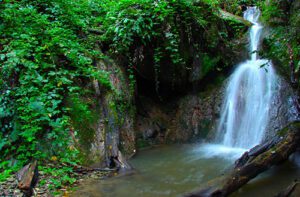


Marvdasht
Marvdasht county is located 40 kilometers north of Shiraz and has a mountainous and mild climate. This city is currently the second largest city in Fars province after Shiraz.
Naqsh-e Rajab, the city of Estakhr, Khan Bridge, Seh Gonbadan, and Amir Band Bridge are among the other historical monuments of Marvdasht. The Kor River, which flows from Bakhtegan Lake and passes through the south of Marvdasht, as well as the Doroudzen Dam Lake have provided pleasant resorts for tourists.

Kazerun
Kazerun city is the center of Kazerun county and has always been attractive due to its numerous historical and ancient monuments.
Most of the historical sights of the city belong to the Sassanid period. The ancient city of Bishapur, located in the center of Kazerun county, was built during the Sassanid period and its remains have been registered as a World Heritage Site by UNESCO, as part of the Sassanid Fars axis. Bishapur is a treasure of Sassanid artifacts such as the Temple of Anahita and the statue of Shapur I located in the Cave of Shapur.

Larestan
With Larestan as its center, Larestan county is one of the cities with a historical background in Fars province, which was a vast land during the Zand and Qajar periods. Most of the people of this city speak Larestani, a branch of the ancient Pahlavi language.
There are many salt domes in this region, which have grown in height over time due to salt deposits and are among the most remarkable tourist attractions of this city.
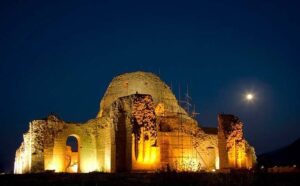
Sarvestan
Sarvestan is home to historical monuments such as the Sassanid Palace, the tomb of Sheikh Yousef Sarvestani, Bibi Sharifeh Khatoon Imamzadeh, and the Angosht Gabri Castle. Maharlu Lake is the most spectacular natural attraction in this county. The Sarv Nokhodi Spring in Nazarabad and the Rabbat Garden are other eye-catching natural sights in the region. Famous products here include yogurt, pistachios, and olives.
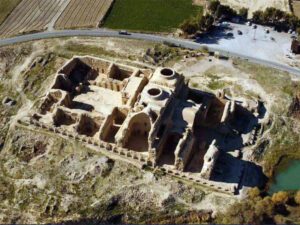
Firouzabad
With Firouzabad as its center, Firouzabad was one of the exceptional cities of the Sassanid period. This region has many historical monuments from the early Sassanid period, including the remains of the Ardashir Babakan Palace, the Maiden Castle, Milo Minaret, and the bas-relief of Ardashir’s victory. This city is the communication route between Bandar Assaluyeh and Shiraz.

Jahrom
Jahrom is one of the old cities of Iran. Jahrom fire temple, Jahrom bazaar, the Stone Carvers’ Cave, Khan Mosque and School, and Toofan House are among the historical monuments of this region. The Stone Carvers’ Cave is one of the largest man-made caves in the world.

Darab
With a history of several thousand years, Darab County is located in the southeast of Fars province. The historical monument of Darabgard, dating back to the Achaemenid period, is located in this county. Azarakhsh fire temple, Naqsh-e Shapur, Azarjou fire temple, and Bahram Palace are among the other historical monuments of the region.
Another tourist attraction of Darab is the Reghez Canyon, which is enclosed by high walls on both sides. It has several waterfalls flowing through. Hiking in the valley requires equipment and a guide and it takes a full day.


Accommodations
Shiraz has numerous hotels and guesthouses, offering a variety of choices for every taste and budget. Some of the hotels include the Shiraz Grand Hotel, Chamran Hotel, Zandieh Hotel, and Homa Hotel. Shiraz Golestan-e Raz, Lotus, Persian Garden House (Khaneh Bagh Irani) in Shiraz, and Toranjestan are also convenient eco-lodges in Shiraz.
Javark in Sepidan, Tang-e Chogan in Kazerun, Dorafshan in Abadeh, Naqsh-e Rostam in Marvdasht, and Gharib Khan in Darab are also some of the eco-lodges in the cities of Fars province.

Local Foods
Fars province hosts travelers with a variety of local dishes offering a unique and exceptional experience to them. Kalam Polo, Polo Esfandi, Do Piaze Aloo, Pache Polo, Shekar Polo, Havij Polo and Kufteh Gheshniz are some of these dishes. Aush-e Sabzi is one of the popular breakfasts in Shiraz. Aush-e Kardeh and Aush-e Anar-e Shirazi are also other local cuisines of this province.
The famous dessert of Shiraz is Faloodeh, and Shirazi salad has also a global reputation.

Restaurants
Haft Khan International Restaurant in Shiraz serves both Iranian and foreign foods; It is one of the famed restaurants in this city. The Panorama Restaurant at Chamran Hotel, Taghche Café-Restaurant, and Bagh-e Raz Restaurant are other eateries in Shiraz. Dagh-e Dagh Fast Food, Pizza Napoli, and Pizza Zaver are also good options for eating foreign foods and fast food. If you are interested in cafes and drinking coffee, Ferdowsi Cafe, Hedayat Cafe, and Pirsook Cafe are some of the good cafes in the city.
The Bamdad House Eco-Lodge-Restaurant in Pasargadae and the Parsian-e Takht-e JamshidRestaurant in Marvdasht are also other options available in this province.

Handicrafts
The most important handicrafts of Fars province are Gilim, rug, and Gabbeh. In addition, Khatamkari is famous and remarkable here. Marquetry, wood painting and pottery, Moaraq tiles tile and seven-color tile are also common in Fars province. They are among the handicrafts of this province beside silk dyeing and metalworking.

Souvenirs
Khatam and carpet of Shiraz, Gilim, and Jajim made by Fars nomads are unique choices for buying souvenirs from this province. Bahar Naranj (Bitter orange Blossom) herbal drinks, Yukheh bread, and Muscat are also among the foods that you can purchase as souvenirs.
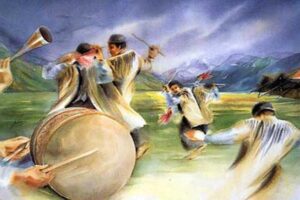
Customs and Traditions
Different ethnic groups such as Lor, Fars, Qashqai Turk, Tajik, Arab, and Kurd live in Fars province, each with their own customs and traditions.
The music of Qashqai Ashiqs has a high position in the region which is played for joy and sorrow. Wood dance is more attractive among their popular dances due to the way it is performed.
The Hosseini Tasu’a and Ashura ceremonies in Kazerun are one of the most unique ceremonies of its kind in all around the country.








